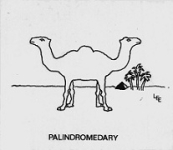 |
Lee Sallows |
|
|
|
|
The Impossible Problem is the name of a puzzle that appeared in Martin Gardner's well-known Mathematical Games column in Scientific American. An essay of same name describing my tussle with the problem was carried by The Mathematical Intelligencer in 1995. In fact, Chandler Davis, the editor, deemed the original article too long, for which reason I was reluctantly forced to make cuts, among them an entire section ('Exploring a Blind Alley'), and a paragraph describing certain qualifications aimed at removing ambiguities. Later it would turn out that the removal of these items left the solution open to criticisms that would not have stood up had it been published in full. A slightly updated version of the original uncut article is available here. Table 3 has likewise been restored.
A further modification concerns the gender of the two protagonists P and S. In the published version, P and S are referred to throughout as he and she, respectively. Later I realized that Gardner himself had used he for both, so that this change was unjustified. It has now been corrected.
A far more important correction to the article is the result of an email I received in March 2012 from Professor Hugo Diniz, a math teacher in Brazil. Diniz wrote to point out errors in Table 2 of the article. Solutions to the puzzle take the form of two numbers. Table 2 records the results of a Pascal program I wrote to identify solution pairs in the case of different upper bounds. Likewise, Diniz had written a Lisp program that models the deductive process whereby P and S are able to infer the other's sum and product, and thus derive solutions for different upper bounds. However, on looking up my old program (still intact on a 7" floppy disk after 17 years) , I was embarrassed to discover a serious oversight that completly explained the discrepancies between our results. Much to my relief, this blunder has no bearing on the main point of the article, which is the solution to Gardner's original puzzle.
My sincere thanks therefore go to Professor Diniz, both for the lively interest he has shown in my essay, as well as for his perspicacity and expertise in straightening out my crooked results. I am very much obliged to him for supplying the figures now recorded in Tables 2 and 3, as well as for his permission to make his two Lisp programs available on this site. They can be found here and here (save and then open with WordPad). In line with these new figures in the tables, certain comments about them made in the body of the text have also been adjusted.
|
Last Updated:
14-6-2020
|
| |
Copyright © Lee Sallows |
|
